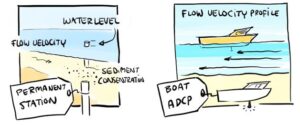Work Package 4 “Events”
WP4. Observation of extreme events
Responsible partner: TUD (Dr. B. van Prooijen)
Extreme events such as storms, droughts and floods play a key role in the morphodynamic evolution of deltas. High floods due to extreme river discharges (e.g. Meuse, 2021) or extreme storm surges (1953 coastal floods) not only pose a safety threat, they also reshape the landscape. In the various deltaic systems, the morphological effect of extreme events depends on the local bathymetry or topography, the spatial distribution of vegetation and the specifics of the storm or flood. These effects cannot be extrapolated from normal conditions. This is especially the case if positive feedback loops develop during the events: intense changes in the bathymetry during the event, in turn change the further effect of the event on the morphology. Understanding of flow, wave and sediment transport patterns during events is therefore needed. To capture these, a mobile set of instruments is proposed to measure during events and where possible/needed before and after events.
The set of instruments will consist of frames for measuring hydrodynamics and sediment transport during events as well as instruments to map (changes in) topography and bathymetry. These data will complement the data obtained from the permanent installations.
As different delta systems face different types of events and conditions, and as the topographies and bathymetries are different, tailored measurements will be carried out. Where possible, instruments are shared. This is the case for the pool of 12 mobile frames, shared between observations in estuaries and river floodplains, and for the LIDAR drone and backpack laser scanner, of which a single instrument will be used in all three systems.

